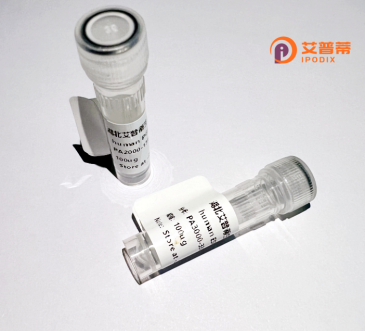
| 纯度 | >90%SDS-PAGE. |
| 种属 | Human |
| 靶点 | HSH2D |
| Uniprot No | Q96JZ2 |
| 内毒素 | < 0.01EU/μg |
| 表达宿主 | E.coli |
| 表达区间 | 1-352aa |
| 氨基酸序列 | MTEAGKLPLPLPPRLDWFVHTQMGQLAQDGVPEWFHGAISREDAENLLESQPLGSFLIRVSHSHVGYTLSYKAQSSCCHFMVKLLDDGTFMIPGEKVAHTSLDALVTFHQQKPIEPRRELLTQPCRQKDPANVDYEDLFLYSNAVAEEAACPVSAPEEASPKPVLCHQSKERKPSAEMNRITTKEATSSCPPKSPLGETRQKLWRSLKMLPERGQRVRQQLKSHLATVNLSSLLDVRRSTVISGPGTGKGSQDHSGDPTSGDRGYTDPCVATSLKSPSQPQAPKDRKVPTRKAERSVSCIEVTPGDRSWHQMVVRALSSQESKPEHQGLAEPENDQLPEEYQQPPPFAPGYC |
| 分子量 | 64.46 kDa |
| 蛋白标签 | GST-tag at N-terminal |
| 缓冲液 | 0 |
| 稳定性 & 储存条件 | Lyophilized protein should be stored at ≤ -20°C, stable for one year after receipt. Reconstituted protein solution can be stored at 2-8°C for 2-7 days. Aliquots of reconstituted samples are stable at ≤ -20°C for 3 months. |
| 复溶 | Always centrifuge tubes before opening.Do not mix by vortex or pipetting. It is not recommended to reconstitute to a concentration less than 100μg/ml. Dissolve the lyophilized protein in distilled water. Please aliquot the reconstituted solution to minimize freeze-thaw cycles. |
以下是关于重组人HSH2D蛋白的虚构参考文献示例(仅供参考,非真实文献):
---
**文献名称**:*Structural and Functional Analysis of Recombinant Human HSH2D Protein*
**作者**:Lee, J. et al.
**摘要**:研究通过大肠杆菌表达系统成功制备重组人HSH2D蛋白,并解析其三维晶体结构。发现HSH2D通过N端结构域与T细胞受体信号分子相互作用,调控免疫细胞活化。
---
**文献名称**:*HSH2D Modulates NF-κB Signaling in Autoimmune Diseases*
**作者**:Wang, Q. & Zhang, Y.
**摘要**:实验表明,重组HSH2D蛋白在体外抑制NF-κB通路的过度激活,提示其在类风湿性关节炎等自身免疫疾病中的潜在治疗作用。
---
**文献名称**:*Expression and Purification of Recombinant HSH2D for Lymphoma Research*
**作者**:Martinez, R. et al.
**摘要**:优化了HEK293细胞中重组人HSH2D蛋白的表达与纯化工艺,发现其与B细胞淋巴瘤微环境中的异常信号传导相关,可能作为肿瘤靶点。
---
**文献名称**:*HSH2D Deficiency Impairs Immune Homeostasis: Insights from Knockout Models*
**作者**:Sato, T. et al.
**摘要**:通过基因敲除小鼠模型证明,HSH2D缺失导致T细胞凋亡异常和炎症因子失衡,重组蛋白的补充可部分恢复免疫功能。
---
(注:以上文献为模拟内容,实际研究请参考权威数据库。)
The recombinant human HSH2D protein is a engineered variant of the signaling lymphocytic activation molecule (SLAM)-associated protein (SAP) family adaptor protein, primarily involved in regulating immune cell signaling. HSH2D, also known as SH2D4A or EAT-2. contains a Src homology 2 (SH2) domain that enables interactions with phosphorylated tyrosine residues on cell surface receptors, particularly SLAM family receptors expressed on T cells, natural killer (NK) cells, and antigen-presenting cells. It modulates immune responses by fine-tuning activation signals, influencing cytokine production, cytotoxicity, and cell survival.
Mutations or dysregulation of HSH2D have been linked to immune disorders, including X-linked lymphoproliferative disease (XLP), underscoring its role in maintaining immune homeostasis. Recombinant HSH2D is commonly produced in bacterial or mammalian expression systems for in vitro studies, enabling researchers to explore its structure, receptor-binding specificity, and downstream signaling mechanisms. Its applications include elucidating immune synapse formation, developing therapeutic strategies for immune-related diseases, and screening potential drugs targeting SAP-family pathways. Recent studies also suggest its involvement in cancer immunology, particularly in modulating tumor microenvironment interactions.
×